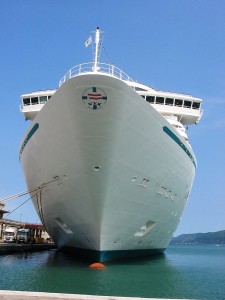
As sea ice melts and temperatures rise, the Arctic is seeing an increase in vessel traffic, but it’s not just icebreakers and research vessels making the journey up north. Cruise ships, mainly European ones, are also taking advantage of the region’s more navigable waters.
They’re hard to miss. Most of them wear matching red jackets. Many carry around identical ship-issued polyester backpacks, juxtaposed by their designer genuine leather rolling suitcases. They’re usually only in town for a few hours, half a day at most, enough time to walk the length of Front Street, get bused around the outskirts of town, and be back to the port by dinnertime.
Cruise ship passengers are an increasingly common sight during Nome’s summer. But unlike the tourists that flood the streets in March for the Iditarod, passengers aboard ships like the Bremen, a German cruise ship that passed through Nome earlier this month, a majority of them are European and know very little of what Nome has to offer. In fact, many only know the town for its role in the Last Great Race.
Waltraud, a passenger from Nuremberg, Germany was quick to admit that she only knew Nome for the Iditarod. While it’s her fourth time aboard the Bremen, it’s her first in Nome. Waltraud explained she and her husband like to travel to colder climates, visiting remotes places like the Norwegian Arctic island of Spitsbergen to see polar bears. They’ve also sailed all the way down to Antarctica to see penguins.
The Bremen will sail across the Bering Strait to the Russian port of Provideniya, where the ship’s itinerary suggests passengers could see whales, seabirds, walruses, and seals. It will then sail down the Kamchatka Peninsula, through the Kuril Islands, and eventually dock at Japan’s western coast after more than three weeks at sea.
While Waltraud and over 100 other passengers are beginning their trip aboard the Bremen, many have reached Nome at the end of their journey, and are crossing paths over lunch at Old St. Joe’s Church.
“We did, by ship, the Northeastern Passage from Tromsø to Nome and it was just great, it was just great,” said Susan, a Swiss passenger. She is also not a first timer aboard the Bremen, though it was her first time in Nome.
Susan recounted her journey with a smile across her face, adding “we liked the tundra, the flowers, and the animals. We saw icebergs and moose and a lot of fishes. It was great.”
So why are so many Europeans choosing to set sail through the Arctic?
Andrew Mew, a vessel agent for Cruise Line Agencies of Alaska, thinks history has a lot to do with the popularity of Arctic cruises among Europeans. “I think it’s a combination of, well the fact that wealthy Europeans have been trying to do the Northwest Passage for about the last six hundred years,” explained Mew.
He says that the emphasis of leave time and the value of travel in European society are other factors that account for the large numbers of European cruise ship passengers that come through Nome.
But, as Mew suggests, recent activity in Alaska may lead to more visits by American tourists.
“With the President’s visit up here, with America taking the Chairmanship of the Arctic Council there’s been more discussion of the Arctic, at least in the United States,” Mew said, adding “I would expect that might produce a slight jump in U.S. passenger interest in the Arctic.”
Next year might see more than just a slight jump in American passengers passing through Nome, as the English-speaking cruise ship the Crystal Serenity will make call to port here next August on its way up to the Northwest Passage. While most of the cruise ships that come through Nome carry about 150 passengers, the Crystal Serenity will have over 1,000, nearly tripling the number of cruise ship passengers that Nome is used to hosting in one summer.
While it will be the first passenger ship of its size the traverse the once fabled and elusive Northwest Passage, the Crystal Serenity is just another sign that tourism is expanding and diversifying in response to the rapidly melting Arctic.
Emily Russell is the voice of Alaska morning news as Alaska Public Media’s Morning News Host and Producer.
Originally from the Adirondacks in upstate New York, Emily moved to Alaska in 2012. She skied her way through three winters in Fairbanks, earning her Master’s degree in Northern Studies from UAF.
Emily’s career in radio started in Nome in 2015, reporting for KNOM on everything from subsistence whale harvests to housing shortages in Native villages. She then worked for KCAW in Sitka, finally seeing what all the fuss with Southeast, Alaska was all about.
Back on the road system, Emily is looking forward to driving her Subaru around the region to hike, hunt, fish and pick as many berries as possible. When she’s not talking into the mic in the morning, Emily can be found reporting from the peaks above Anchorage to the rivers around Southcentral.




